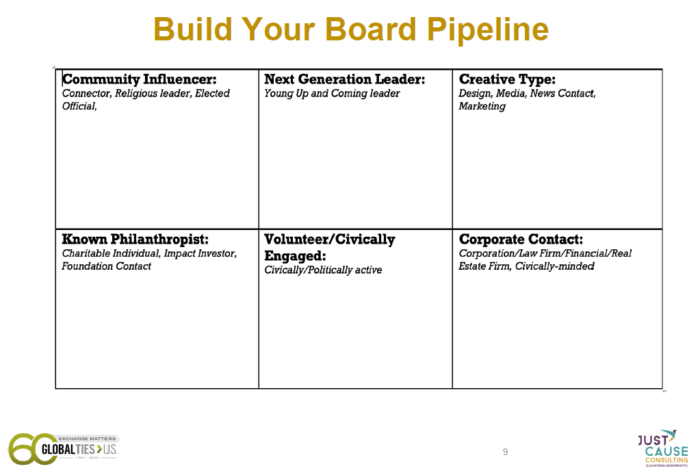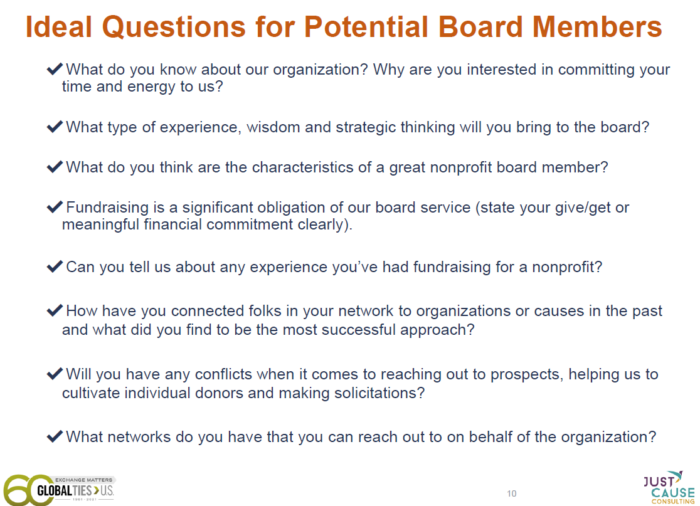By Stephen Quinn, Associate Director, Development, and Charlie Shapiro, Development Intern, Global Ties U.S.
Board members lend their time, expertise, and reputation to your organization. By taking on this responsibility as volunteer leaders, they demonstrate their commitment to your mission and their trust in the organization. Ensuring that your organization has adequate resources is a key responsibility for the board, so it’s critical that they play a role in the fundraising process.
So how do you inspire and empower them to help financially sustain your mission? This article presents some ideas from our webinar on “Engaging Your Board in Fundraising” with Cecilia Cross of the San Antonio Council for International Visitors (SACIV), and Lisa Acker and Nancy Kohn of Just Cause Consulting (member login required).
Step 1: Recruit and Diversify Your Board
A balanced board includes diversity of races, ages, abilities, and experiences: Community leaders, young professional leaders, creatives or people with specific skills, corporate, civically engaged, known philanthropists. Organizations should identify connections and actively engage with community leaders that will help your organization and the Global Ties Network grow.
Cecilia, Executive Director of SAVIC, suggests widening your pool of board candidates through local professional leadership programs and organizations.

Step 2: Communicate Your Expectations
Vet board candidates on their experience and be upfront about fundraising responsibilities.

Source: Joan Garry
Educate board members on the fundraising cycle. Each stage of this cycle – identify, cultivate, solicit, acknowledge, and steward – is equally important and offers a variety of ways to engage the board in fundraising activities in order to find the right roles for each board member based on their unique strengths and giving ability.
For example, a board member who is well-known and well-connected in your community may be especially helpful in identifying new prospects and inviting them to events, whereas a youth member or home hospitality host serving on your board can help acknowledge and steward donors with personal thank you notes or phone calls. Board members who are reluctant to make an “ask” of their personal or professional contacts might be enthusiastic about inviting friends to attend the annual gala, calling new donors to say thanks, or brainstorming prospects – finding tasks for each board member that they feel comfortable with can help ensure full participation.
Finally, make sure your board members have a strong understanding of and stay true to your mission, policies, programs and needs. At SACIV, board members participate in home hospitality dinners to see exchange programs in action, reinforce the mission, and continuously remind them of their “why.”
Step 3: Equip Your Board
Ensure your board members understand their role in the fundraising process and are in the best position to advocate for your organization and communicate its values and mission.
Tools:
- Individual board member plans that allow board members to select from a menu of activities, such as hosting a dinner, inviting friends to an event, providing a list of potential prospects, sponsoring a table at your annual gala, or making thank-you calls to donors.
- Up-to-date talking points or “elevator speech”
- Customizable templates (event invitations, meeting requests, etc.) for personalized outreach to (potential) donors
- Relationship mapping worksheets that allow board members to identify connections to prospects
Attend trainings with your board members and discuss key takeaways to expand nonprofit management skills together. Global Ties U.S. and the Network have a variety of training opportunities to engage Board Members:
- Capacity building grants can help with board cohesiveness and allows for more bonding events
- Have board members attend Global Ties National Meeting sessions designed to help them understand the CPG grants and funding
- Add the IVLP Fundamentals online course to board onboarding requirements to reinforce the mission and provide context to the CBMs’ role in the greater Global Ties Network
Step 4: Once your board is set, inspired, and equipped, be clear with the organization’s needs and consistent with checking on progress toward fundraising goals. Lisa and Nancy shared these tips for getting the most out of your board:
- Set clear defined timelines and deadlines when working with a board member
- Acknowledge and run with great fundraising ideas from board members if they align with the mission and are accountable.
- Avoid making broad requests to the group over email or at board meetings. Need individual accountability by checking on each board member’s progress
- Use peer driven accountability
- Double down on stewardship – continually thank supporters for their loyalty and wish them well during the crisis. Investing in relationships now can help and ensure donors stick with you in the future.
For more advice, watch the webinar and check out these other articles:
